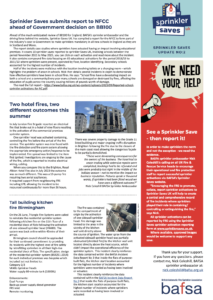
- This event has passed.
Two Care Home Fires With Two Different Outcomes…….
16 September 2023 @ 2:04 am - 6:25 pm

click below in the links section to open the Newgrange Care Home case study Think Sprinkler Video
The video features an audio recording, images of the tragic fire that devastated a residential care home in Hertfordshire in 2017. Firefighters evacuated more than 30 residents but sadly two people lost their lives, sprinklers were not fitted.
- The inquest into the deaths concluded “inadequate compartmentation in the roof space had contributed to their deaths”.
- Evidence from the fire service and an independent fire safety expert highlighted. If a sprinkler system had been installed, the two deaths were likely to have been prevented.
When you compare this incident to a fire involving a real tangible example reported by Kent Fire Rescue Service where fire sprinklers have actuated and in doing so saved life and protected property within a sprinklered protected residential care home fire the outcome of this fire was so much different.
This is why the British Automatic Fire Sprinkler Association (BAFSA) The National Fire Chiefs Council are calling for all new build residential care homes to be fitted with sprinkler systems. However, unlike in Scotland, Wales there is no building regulation requirement in England for care homes to be fitted with sprinklers.
It is therefore disappointing and difficult to understand how Newgrange Care Home has been rebuilt without sprinklers installed, against the recommendation of Hertfordshire Fire and Rescue Service.
BAFSA strongly welcomes the governments consultation proposing to require sprinklers in all new build care homes, this is a change that the fire sector, fire rescue service has been calling for as these types of premises present a series of unique challenges with respect to fire safety.
- The needs of the occupants and the resources required to undertake an evacuation in these types of premises require careful consideration both in the design and ongoing operation of such buildings, to ensure that an appropriate level of fire safety is provided.
- The diminished senses that result from the ageing process may ultimately result in the occupants of residential care premises having a slower reaction time to raise an alarm, and due to the residents’ reduced physical capabilities, a slower response time to an alarm, which may result in an increased evacuation time.
- Significantly reduced staff numbers, particularly at night, and may be unable to undertake a safe and effective evacuation of residents.
All the above- mentioned factors combine to increase the risk of injury or fatality in a fire, especially where assistance from carers may be restricted at night. Where residents require assistance, it is likely that the evacuation process will take longer.
Residential fire sprinklers provide significant benefits to address this risk as part of a package of fire safety measures.
Kent Residential Care Home Sprinkler Activation
- Date of incident; 16 September 2023.
- Tine of call; 02:04.
- Time of stop; 06:25.
- Location; Seven Oaks.
- Use of building; Care Home.
- Location of fire; Room.
- Automatic Fire Suppression System; Sprinklers.
- Fire Rescue Service; Kent Fire & Rescue Service. (KFRS)
The Premises
- Two-storey residential care home providing accommodation and personal care for older adults some of whom are living with dementia.
The Incident
- Fire crews were initially mobilised to reports of the automatic fire alarm sounding within the building, en route information was received from fire brigade control of smoke logging in the corridor of the premises upgrading the incident to a fire call.
- On arrival it was identified that the premises emergency plan (Progressive Horizontal Evacuation) had been implemented by staff moving residents away from the affected fire compartment on the first floor of the premises.
- Breathing apparatus team were committed to locate, extinguish the fire.
- Upon entry to the room of origin the seat of the fire was established to involve upholstered furniture which had been successfully contained, extinguished by the activation of one sprinkler head located within the room of origin.
- No further firefighting media was required with no rapid-fire growth reported.
- The seat of the fire, upholstered furniture was removed from the room of origin.
- To assist with ventilation within the building, a positive pressure ventilation fan was used to remove smoke from within the premises.
- 2 minor casualties were reported.
- Ignition source, cigarette lighter heat source and combustibles brought together.
It should be remembered.
- The fire was extinguished, controlled within the compartment of origin by the activation of the sprinkler system.
- Minimal fire damage was reported within the compartment of origin.
- No further firefighting media was required.
- The sprinkler system maintained the care homes continuity of providing care to their residents with minimal disruption, valuable community asset saved.
Premises Sprinkler System
- BS9251:2014: – Category 3.
- Density mm/min (l/min/M2): – 2.80mm.
- Sprinkler Pipework: – CPVC.
- Source and duration of supply: – BCWS 30 Minutes.
Links/sources
- Sprinkler Saves Review 2022/2023
- Sprinkler Saves Spring Update No 4
- BAFSA Information File 14 Fire Sprinkler Systems in Care Homes
- NFCC Press release Families back NFCC’s Think Sprinkler campaign
- Newgrange Care Home case study Think Sprinkler Video
- LFB Consultation response Sprinklers in Care Homes
- Kent FRS
If you want to make a difference working in the fire sector, we need your assistance……
To make sprinklers the norm and not the exception – we need the evidence. Encouraging FRS and those in the sprinkler community to promote, collate, report sprinkler activations to Sprinkler Saves UK which will help to create a central and comprehensive record of fire incidents where sprinklers played their role in containing/controlling or extinguishing the fire.
If you hear of a save report it using this link


